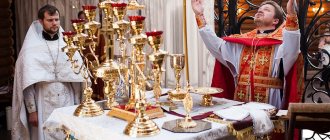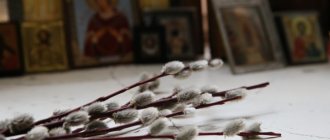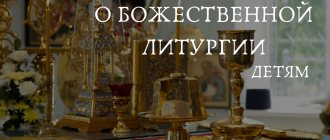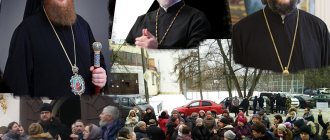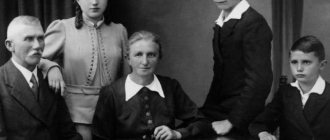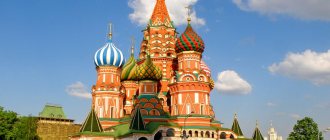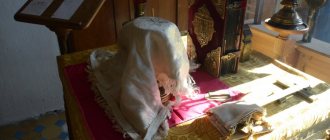| Metropolitan Diokleian Callistus (Ware) |
Callistus (Ware)
(b. 1934), Metropolitan of Diocleia (Orthodox Church of Constantinople) In the world Timothy (Timothy) Ware (Timothy Ware), was born in 1934 in the city of Bath, Somerset, Great Britain, into a believing Anglican family.
He was educated at Westminster School and Magdalen College, Oxford University.
At the age of 17, I first became acquainted with the Orthodox Church. His spiritual development was greatly influenced by Father Vasily (Krivoshein) (future archbishop), N.M. Zernov and Archimandrite Lev (Gillet). In 1958, Timothy Ware converted to Orthodoxy.
In 1963, he spent six months in the monastery of the Russian Orthodox Church Outside of Russia in Canada. In the mid-1960s he returned to Britain and became secretary to Athenagoras II (Kokkinakis), Archbishop of Thyatira.
In 1965 he was ordained to the rank of deacon.
| Metropolitan Callistus (Ware) |
He spent a long time in the monastery of St. John the Theologian on the island of Patmos (Greece), where in 1966 he became a monk with the name Kallistos.
He also often visited Jerusalem and Holy Mount Athos. In 1966 he was ordained to the priesthood.
From the same year until his retirement in 2001, he taught Orthodoxy at Oxford University.
In 1982 he was ordained Bishop of Diocleia, Vicar of the Archbishop of Thyatira and Great Britain (Patriarchate of Constantinople). After his episcopal consecration, he remained in Oxford, where he continued to head the Greek Orthodox parish and lecture at the university.
After retiring in 2001, Bishop Kallistos continued to actively publish his works and give lectures on Orthodoxy. Until recently, he chaired the board of directors of the Institute of Orthodox Christian Studies in Cambridge. Chairman of the group Friends of Orthodoxy on Iona.
On March 30, 2007, he was elevated to the rank of metropolitan by a unanimous decision of the members of the Holy Synod of the Patriarchate of Constantinople.
In January 2008 he was elected corresponding member of the Academy of Athens.
| Metropolitan Callistus (Ware) |
influence
Was under the influence of Fr. Georgy Florovsky and Vladimir Lossky:
Two Russian Orthodox theologians, Russians in exile, particularly influenced me. The first was Father Georgy Florovsky, who taught first in Paris, then in New York, at Harvard. And the second who influenced me was a lay theologian, Vladimir Lossky, he lived in Paris. I was lucky enough to know them personally. These people inspired me to join the Orthodox Church through their written works, through their testimony of Orthodox truth. And these people inspired me all these 35 years of teaching at Oxford University, they inspired me with a special approach to the study of the Holy Fathers. They urged that they should not be seen as voices from the distant past. We must look at the fathers of the early Christian period as our contemporaries. The Orthodox Church is a Church of tradition, but we mean that it is a living tradition[1].
Among the students of Met. Callista (Uera): Met. Hilarion (Alfeev), Fr. Irenaeus (Steenberg), Fr. John Behr, Fr. Nikolai (Sakharov).
education
Graduated from Westminster School and St. Magdalene College (classical philology and theology).
From 1966 to 2001 he taught at Oxford University: “Oriental Orthodox Studies” under a grant from the Spalding Foundation. Fellow of Pembroke College.
Chairman of the Board of Directors of the Cambridge Institute of Orthodox Christian Studies.
Member of the Board of Trustees of the Biblical-Theological Institute.
He gives numerous lectures on Orthodoxy in different countries.
Doctor honoris causa of the All-Church Postgraduate and Doctoral Studies named after Saints Cyril and Methodius (2014).
Metropolitan Callistus (Ware): for the liturgy, the main thing is not the priest or the temple, but the congregation
Inspired by the liturgy, we must study, teach, write, bring light and knowledge to places where there is ignorance. In addition, considering that we are people and consist not only of soul, but also of body, we must help people according to the flesh wherever there is poverty and illness. We must try to transform all this in the Eucharistic spirit. Therefore, liturgy means the widest range of social activities, from the personal level to the most organized.
But non-Christians also do excellent work in the direction of knowledge and enlightenment, and also fight poverty and disease. We shouldn't say that we as Christians are the only ones who do this. But we do this for a specific reason: because of the gift that Christ gave us at the Eucharist. Therefore, we have a special motive: Christ died for us on the Cross and rose from the dead - this is what we remember every time we celebrate the Eucharist, and this is what inspires us to go into the world and help people in the spirit of the Eucharist.
You called parishes the basis of the future of the church. What do you understand by parishes? After all, we see so many examples when parishes were destroyed for one reason or another: take the parish of Metropolitan Anthony of Sourozh, the main part of which was forced to leave for another church when he died. In what sense should the word “arrival” be understood?
Metropolitan Kallistos:
By the word “parish” I mean, first of all, the space where the divine liturgy is celebrated. It is good when a parish has its own church and when it is large and beautiful, we can rejoice in it. But often in the 20th century, during times of persecution, Christians lost their churches, and they had to celebrate the liturgy in hidden and secret places, in detention cells, in heated vehicles, hiding. Therefore, church buildings are secondary.
Again, it would be ideal if each parish had a full-time priest, or several priests. But in the 20th century, in many places, especially during times of persecution, Christians were forced to survive without a permanent priest. The priest could come only occasionally, with long breaks. But they were still able to survive, and even if they could not celebrate the liturgy, they were still able to live the Eucharistic life in their hearts.
Therefore, when we think about parishes, we should not primarily think about outward manifestations of religiosity. Yes, a priest is needed to celebrate the Eucharist, but priests are not the church. The Church is all of us, you and I, we will all communicate with each other in the body and blood of Christ. The essence of a parish is not to have a council and elected council members, this is all secondary, the essence is to participate together in the Eucharist.
Can we talk about a parish as a community?
Metropolitan Kallistos:
A parish is a community of people who gather together and have fellowship in the holy sacraments.
Do you pin the hopes and future of the church on this?
Metropolitan Kallistos:
Yes exactly. Those who lived through the experience of the Russian Church in the crazy events of 1917 lost all their income, were deprived of all their material resources, and the churches were closed. But the communities continued to exist, faith remained in the hearts of living people. Therefore, the church is living people, and the parish is living people. It is important. It's not the institutions that matter, it's the people.
Some people still view the church as part of the state, as a state institution. How can we change this approach?
Metropolitan Kallistos:
It is true that in the past, in Byzantium and the post-Byzantine world, in Russia, the church was from many points of view a state structure. The state supported the church financially. The state supported an educational system in which the Christian faith was taught. And the state often interfered in the appointment of bishops and controlled the church in ways that were not always beneficial to the church. However, this is over. In the 20th century, in different countries, the traditional connection between church and state was weakened or even completely disappeared.
We must also accept the fact that today only a very small minority of people go to church. It is difficult to calculate the number, but even in a country like Greece, the number of people who are in church every Sunday is only a small part of the total population. And the situation is definitely the same in Russia.
But I don't think we should try to go back in time. In many places, Christians experience a certain nostalgia for the state church, I saw this in Russia as well. I don't think that's the future of the church.
Interviewed by Arina Filippova. Oxford. Especially for the SFI website
events
- XI General Assembly of Syndesmos (14 August 1983)
- Consultation of Orthodox Theological Schools, Halki, 1994 (13 August 1994)
- Legacy of Father John Meyendorff (colloquium) (February 9, 2012)
- Blessed are the peacemakers (symposium) (September 3, 2014)
- Mercy and Forgiveness (Symposium) (September 9, 2015)
- Eighth Ecumenical Council (June 19, 2016)
- XIV plenary meeting of the Mixed Commission on Orthodox-Catholic Dialogue (September 16, 2016)
views
Universal Salvation, Theory of Evolution
female priesthood
A supporter of the expansion of women's rights in the Orthodox Church, in which he collaborated with the Orthodox feminist Elisabeth Behr-Sigel. Back in 1982 he announced his support for the idea of a female priesthood. In 1998, together with Elisabeth Ber-Sigel, he published the book “The Ordination of Women in the Orthodox Church.”
In 2008, at the Lambeth Conference of the Church of England, Met. Callistus (Ware) called the Anglican decisions on the ordination of women and the “blessing” of sodomites “prophetic for all Christianity.”
evolutionism
Metropolitan Callistus (Ware) defends the theory of evolution from creationism, based on the doctrine of “two truths”: religious and scientific.
quotes
About the female priesthood:
For us, this is essentially an open question. We are not suggesting that we do this in the near future, but we need to think more deeply about it
As for this essay (“Men, Woman and the Priesthood of Christ”), in it I have revised and developed my ideas expressed in 1978. Since then, my views on this issue have changed greatly. In 1978, I considered the ordination of women impossible. Now I'm not sure about that. I am far from convinced by the arguments of modern supporters of the female priesthood, but at the same time, the objections of opponents seem to me much less convincing now than they did then. And I ask that this question be considered open. One should not think that in this area everything has become clear and has fallen into place - this is clearly not the case both for the Orthodox and for representatives of other faiths[3].
About homosexuality:
In the modern world it is quite clear - and the Orthodox also belong to the modern world - that the whole problem of human sexuality will be explored more and more.
In my opinion, in the 21st century the main focus of Orthodox theology will be on anthropology rather than ecclesiology. Now we will be occupied with the question not so much of what the Church is, but of who the person is. Christians are faced with an increasing number of experiments in the field of bioethics, and especially with the fact that in other faiths some people have ceased to consider issues of marriage and gender relations as important. Gender relations in particular today raise many questions from a theological perspective. We cannot seek a way out of these problems without delving deeply into the mystery of the human being[4].
Bishop Callistus (Ware) – Orthodox Church
Orthodox Church
PART ONE. STORY
START
The village has a prayer house dug deep underground, with a carefully camouflaged entrance. When a secret priest visits a village, it is here that he performs the Liturgy and other services. If the inhabitants feel free from police surveillance, then the entire population gathers in the prayer house - except those who remain outside on guard in order to give a sign in case of strangers. In another situation, services are attended in turns...
The Easter service took place in the premises of an official government institution. It was possible to enter only with special passes, which I managed to get for myself and my daughter. Approximately thirty people were present; some were familiar to me. The old priest led a service that I will never forget. "Christ is Risen!" - we sang quietly, but filled with jubilation... The joy I experienced at that service in the catacomb church, right up to this day, gives me the strength to live.
These two passages [1] tell the story of the life of the Russian Church shortly before World War II. But with minor amendments they could also be attributed to the era of Nero or Diocletian. They outline the circular path that the history of Christianity has traversed over nineteen centuries. The circle is closed. Today's Christians are closer to the early church than their forefathers and great-grandfathers. Christianity arose as a small minority religion surrounded by a predominantly non-Christian population; and in our days it has returned to the same state. In the early era the Christian church was distinct and separate from the state; and today, in one country after another, the traditional alliance between church and state is coming to an end. In the beginning, Christianity was religio illicita - a forbidden religion, persecuted by the authorities; and today persecution is no longer just a historical fact. Perhaps in the thirty years between 1918 and 1948. More Christians died for their faith than in the three hundred years that followed the crucifixion of Christ.
Members of the Orthodox Church feel this especially acutely because the overwhelming majority of them, until very recently, lived under the rule of an anti-Christian communist regime. The first period of Christian history - from the day of Pentecost to the conversion of Constantine - is especially significant for modern Orthodoxy.
“And suddenly there came a sound from heaven, as of a rushing mighty wind, and it filled the whole house where they were sitting; and cloven tongues as of fire appeared to them, and one rested on each of them. And they were all filled with the Holy Spirit" (Acts 2:2-4). This is how the history of the Christian church began - with the descent of the Holy Spirit on the apostles in Jerusalem during the holiday of Pentecost. On the same day, after the sermon of St. Peter, three thousand men and women were baptized and the first Christian community in Jerusalem was formed.
Soon, members of the Jerusalem Church scattered around the world as a result of the persecution that followed the death of St. Stefan. Christ commanded: “Go therefore and teach all nations” (Matthew 28:19). Obeying this commandment, they preached wherever they went: first to Jews, but soon to non-Jews too. Some episodes of these apostolic wanderings were immortalized by St. Luke in Acts, others have been preserved by church tradition. In an astonishingly short period of time, small Christian communities spread throughout all the major urban centers of the Roman Empire and even beyond.
The empire through which these early missionaries roamed was, especially in the eastern part, an empire of cities. This fact predetermined the administrative structure of the original church. The main structural unit was the city community, ruled by a bishop; Presbyters (priests) and deacons were given to help the bishop. The rural district was subordinate to the city church. This model, with its characteristic tripartite ministry of bishops, presbyters and deacons, was established in some localities by the end of the first century. This is clear from seven short epistles written by St. Ignatius, Bishop of Antioch, around 107 on his way to Rome, where he faced martyrdom. Ignatius emphasizes two things: the authority of the bishop and the Eucharist. He views the church as a hierarchical and at the same time sacramental organism. “The bishop of each church,” writes Ignatius, “presides in the place of God.” “Without a bishop, no one should do anything pertaining to the church... Where there is a bishop, there must be a people, just as where Jesus Christ is, there will be the Catholic Church.” The first and main duty of the bishop is the service of the Eucharist - “this healing of immortality” [2].
People today tend to think of the church as a worldwide organization in which each local congregation is part of a larger, more inclusive whole. Ignatius looked at the church differently. For him, the local church is the Church. In the church he sees the Eucharistic assembly, which realizes its true nature only in the celebration of the Lord's Supper, in the reception of the body and blood of Christ in the sacrament. But the Eucharist can only be celebrated locally - in each individual community gathered around its bishop; and in every local celebration of the Eucharist the whole Christ is present, and not a part of Him. Therefore, every community that celebrates the Eucharist Sunday after Sunday is the Church in its entirety.
The teachings of Ignatius are integral to the Orthodox tradition. Orthodoxy continues to see the church as a eucharistic assembly whose external organization, for all its importance, is secondary to its internal sacramental life. Orthodoxy continues to emphasize the centrality of local communities in the structure of the church. Anyone who has attended an Orthodox hierarchical liturgy [3], when the bishop at the beginning of the service stands in the middle of the church, surrounded by his flock, finds the idea of the bishop as the unifying center of the local community, expressed by Ignatius of Antioch, to be especially vital.
But beyond the local community there is also the wider unity of the church. This second aspect was developed in the works of another martyr bishop - St. Cyprian of Carthage (+ 258). Cyprian believed that all bishops share a single episcopate, however, they share in such a way that each owns not a part, but the whole. “The episcopate,” writes Cyprian, “is a single whole, which every bishop fully possesses. So the church is a single whole, although it spreads in breadth into many churches as its fertility increases” [4]. There are many churches, but only one Church; there are many episcopi, but only one episcopate.
In the first three centuries of church history there were many other Christians who, like Ignatius and Cyprian, ended their lives as martyrdom. Of course, persecutions often had a local character and did not last long. But although for long periods the Roman authorities treated Christianity quite tolerantly, the threat of persecution always remained, and Christians knew that at any moment it could become a reality. The idea of martyrdom occupied a central place in the spiritual life of early Christians. For them, the church stood on blood - not only the blood of Christ, but also the blood of the martyrs. In later centuries, when the church was “institutionalized” and was no longer persecuted, the idea of martyrdom did not disappear, but took on other forms: for example, monastic life is often considered by Greek authors as equivalent to martyrdom. A similar approach is observed in the West: take, for example, a Celtic text - an Irish homily of the 7th century, where the ascetic life is likened to the path of martyrdom:
So, there are three types of martyrdom that are counted as a Cross to a person: white martyrdom, green martyrdom and red martyrdom. White martyrdom consists in renouncing everything that a person loves for the sake of the Lord... Green martyrdom consists in freeing oneself from evil desires through fasting and labor and bearing the burden of repentance. Red martyrdom consists of bearing the Cross, or accepting death for the sake of the Lord.
For long periods of Christian history, the prospect of red martyrdom remained distant, and white and green forms of martyrdom predominated. However, there were also times—primarily in our century—when Orthodox and other Christians again found themselves called to martyrdom of blood.
For bishops who, as Cyprian emphasizes, share a single episcopate, there was nothing more natural than meeting in councils to discuss common problems. Orthodoxy has always emphasized the importance of the role played by councils in the life of the church. In Orthodoxy, the cathedral is considered the highest body through which God is pleased to guide his people, and the Catholic Church is seen as essentially a conciliar church. (In Russian, the adjective “soborny” itself has a double meaning: “universal” and “pertaining to the cathedral”; and the corresponding noun “cathedral” means both “church” and “council, assembly.”) There is no dictatorship in the church, There is no individualism, but there is harmony and unanimity. Its members are free, but not isolated, for they are united in love, faith and communion in the sacraments. The cathedral embodies this idea of harmony and free consent. In a true council, not a single participant imposes his will on others, but everyone consults with the others, and thus everyone freely comes to a common opinion. The cathedral is the living embodiment of the essential nature of the church.
essays
- Callistus (Ware)
The Orthodox Church (1963), Russian. lane "Orthodox Church" (2001); M.: BBI, 2011 - Callistus (Ware)
Eustratios Argenti: A Study of the Greek Church under Turkish Rule (1964) - Callistus (Ware)
, Fr. The Orthodox Way (1979), Russian. lane "Orthodox Path" (2005) - Callistus (Ware)
, Fr. Communion and Intercommunication (1980) - Callistus (Ware)
, bishop. Praying with Orthodox Tradition (1990) - Callistus (Ware)
, bishop. How Are We Saved?: The Understanding of Salvation in the Orthodox Tradition (1996) rus. lane The doctrine of salvation in different Christian denominations. M.: BBI, 2005 - Callistus (Ware)
, bishop. “We Must Pray for All”: The Salvation of the World According to St Silouan // Sobornost. V. 19. No. 1. P. 51-53 Rus. lane “We need to pray for everyone.” Salvation according to the teachings of St. Silouan of Athos / Trans. O. Hilarion (Alfeev) // Church and Time. 1999. No. 2 (9). pp. 231-258; Published in abbreviation: Alpha and Omega. 1998. No. 3 (17). pp. 113-117 - Callistus (Ware)
, bishop. L'Ordination des femmes dans l'Église orthodoxe (1998), Russian. lane "The Ordination of Women in the Orthodox Church" (2000) - Metropolitan Callistus (Ware): “I welcome it when people often receive communion” // Orthodoxy in Ukraine. — 2008. — July 31.
- Callistus (Ware)
, Met. A theologian is one who often partakes of the Holy Mysteries // Lumina. October 2, 2011 available at https://www.kiev-orthodox.org/site/meetings/4585/ - Callistus (Ware)
, Met. Orthodox theology in the twenty-first century. Geneva: World Council of Churches, 2012
articles
- Kallistos (Ware), Metr.
Foreword // The Wheel. — 2021. — 13/14. — P. 6-10. - Can C.S. Lewis be considered an “anonymous Orthodox”? // Pages. 1996. 2. P. 102-112.
- On the banks of the Thames and Trent (Orthodoxy on British soil) // Journal of the Moscow Patriarchate. 1993. 10. pp. 88-90.
- Disputes about Palamism in Western theology // Journal of the Moscow Patriarchate. 1992. 5. pp. 40-47.
- Dieu caché et révélé; la voie apophatique et la distinction essence-énergie // Bulletin of the Russian Western European Patriarchal Exarchate. 1975. 89-90. pp. 45-59.
- God and humanity (Chapter 11 from the book: Orthodox Church. M.: BBI, 2001. Sections: Trinity God; Human Person; Holy Spirit; “Participants of the Divine Nature”: deification - redemption and salvation) / Vdovina G. I . (trans.) // Pages. 2000. T.5. No. 3. P. 353-376.
- Personal experience of communication with the Holy Spirit: (Based on the texts of the Greek fathers) / Dmitrievsky P. (trans.) // Pages. 1999. T.4. No. 1. P. 10-23.
- Kenosis and godlike humility according to the teachings of St. Silouan of Athos (Report at the International Conference, dedicated to St. Silouan of Athos. Bose (Italy), October 2-5, 1998) / Hilarion (Alfeev), abbot. (trans.) // Church and time. 2000. 2(11). pp. 256-269.
- Orthodox understanding of ecumenism: Conversation with correspondent. magazine “CiVR” (London, July 14, 1998) / Hilarion (Alfeev), Hierom. (trans.) // Church and time. 1998. 3(6). pp. 78-86.
- “We must pray for all people”: The salvation of the world according to the teachings of Elder Silouan / Kazachkov Yu. A. (trans.) // Alpha and Omega. 1998. 3(17). pp. 113-117.
- The power of the name: The Jesus Prayer in Orthodox spirituality / Kirilenkov A. V. (trans.); Hilarion (Alfeev), Hierom. (ed.) // Church and time. 1999. 1(08). pp. 187-217.
- Do we dare to hope for the salvation of all?: Origen, Gregory of Nyssa, Isaac of Nineveh Kurt A. (trans.) // Pages. 2000. T.5. No. 1. P. 16-36.
- Guide to hesychast prayer of the 14th century: “Sotnitsa” by St. Callista and St. Ignatia Ksanfopulov / Muskhelishvili N. L. (trans.) // Pages. 1998. T.3. No. 1. P. 11-31.
- The Path of the Ascetics: Denial or Affirmation? / Sergeants P.B. (trans.) // Alpha and Omega. 1999. 3(21). pp. 146-162.
- Understanding salvation in the Orthodox tradition / Yastrebov G. (trans.) // Pages. 1996. 3. pp. 17-37.
- Canonization of the Royal Family: pros and cons // Church and Time. 1998. 4(07). pp. 196-197.
- “We need to pray for everyone”: Salvation according to the teachings of St. Silouan of Athos // Church and Time. 1999. 2(09). pp. 231-258.
- Holy Scripture and the Holy Fathers on theological education // Theological collection. 1997. 1. pp. 142-152.
- Through creation to the Creator // Christmas readings, 5th. 1997. -. pp. 157-172.
translator
- The Lenten Triodion (1978)
- Philokalia (four out of five volumes translated)
KALLIST
In his works, K. often addresses the topic of the relationship between Orthodoxy and heterodoxy. His interest in this topic is due to the position he occupies in the West. Christ world. Having converted from Anglicanism to Orthodoxy, but at the same time remaining in England in a teaching position, K. found himself at the epicenter of a discussion on this topic. He expressed his position, in particular, in the book. “Orthodox Church”, where the theme is Christ. The final chapter is devoted to unity (The Orthodox Church. 1963. P. 315-334). He speaks about the same thing in an interview on the topic “Orthodox understanding of ecumenism” (see translation by Hierome Hilarion (Alfeev) - TsiVr. 1998. No. 3(6). P. 78-86). K. emphasizes that his understanding of ecumenism is based on 2 principles. The first is that “The Orthodox Church is the true and only Church of Christ on earth... Within Orthodoxy, and only within it, we can find the fullness of the Truth of Christ.” The second principle is as follows: “Our Lord Jesus Christ at the Last Supper, before His passion, prayed that all His followers would be one: “That they may all be one” (John 17:21). We must take this prayer of our Savior seriously. We cannot, as Orthodox Christians, be indifferent to the fact that today's Christians, followers of Christ, are divided. This division must cause us pain and suffering. Therefore, being Orthodox, we must go out to meet other Christians, we must share with them the treasures of the Orthodox faith, and not remain locked within the walls of our own church and spiritual life. We must listen to other Christians and enter into dialogue. It is not enough to simply tell them about Orthodoxy: we must hear about their own problems and hopes. There must be a dialogue, not a monologue” (Orthodox understanding of ecumenism // TsiVr. 1998. No. 3(6). P. 78-79).
Analyzing the causes of the crisis in which the modern world finds itself. ecumenical movement, K. says that 60 years ago, when this movement came into force, the Anglicans were much closer to the Orthodox than now: “The majority of Anglicans and Protestants unconditionally accepted the doctrine of the Trinity, faith in the deity of our Lord Jesus Christ, in His birth from the Virgin, in His miracles, in His Resurrection. Now, unfortunately, many Western Christians are challenging these fundamental Christian tenets. Extreme liberalism has developed strongly in the West - not only in dogmatic matters, but also in matters of the moral teaching of individual Churches.” However, K. believes that this factor should not be exaggerated. Among the Western There are many Christians who are close to Orthodoxy, and the duty of the Orthodox is to continue dialogue with them (Ibid. p. 79).
Regarding specific theological dialogues, K. gives a generally positive assessment of the Orthodox-Catholic. dialogue, although he believes that its potential is far from exhausted: he, in particular, offers Orthodox. theologians to develop a clear view of the problem of the primacy of the Pope, which is the main stumbling block between Orthodox and Catholics. More positive is K.’s assessment of the dialogue with the pre-Chalcedonian Churches: “I am deeply impressed by the progress achieved in this dialogue,” he says. “And I hope that in my lifetime there will come a complete restoration of visible Eucharistic communion between the Orthodox Church and the Eastern Churches” (There same. P. 81). In this assessment, K. disagrees with another famous theologian belonging to the K-Polish Patriarchate, Metropolitan. John (Zizioulas), who expresses a less optimistic view of the results of the dialogue and the possibility of restoring Eucharistic communion between the two families of the Eastern Churches (see: John (Zizioulas), Metropolitan “Theology is the service of the Church” / Trans.: E. L. Maidanovich // TsiVr. 1998. No. 3(6), pp. 95-96).
Works: The Orthodox Church. Baltimore, 1963 (Russian translation: Orthodox Church / Translation: G. Vdovina. M., 2001, 2011 2); Eustratios Argenti: A Study of the Greek Church under Turkish Rule. Oxf., 1964; The Jesus Prayer in St. Gregory of Sinai // ECR. 1972. Vol. 4. N 1. P. 3-22; The Power of the Name: The Jesus Prayer in Orthodox Spirituality. Oxf., 1974 (Russian translation: The Power of the Name: The Jesus Prayer in Orthodox spirituality / Translation: A. Kirilenkov // TsiVr. 1999. No. 1(8). P. 187-217); Dieu caché et rélévé: La voie apophatique et la distinction essence-énergie // VZEPE. 1975. No. 89/90. pp. 45-59; The Debate about Palamism // ECR. 1977. Vol. 9. N 1-2. P. 45-63 (Russian translation: Disputes about Palamism in Western theology // ZhMP. 1992. No. 5. P. 40-47); The Orthodox Way. Crestwood (NY), 1979 (Russian translation: Orthodox Way / Translation: A. Krasilshchikov. St. Petersburg, 2005); Praying with the Body: The Hesychast Method and Non-Christian Parallels // Sobornost. 1992. Vol. 14. N 2. P. 6-35 (Russian translation: Praying with the body: Hesychast method and extra-Christian parallels // Symbol. 2007. No. 52. P. 13-50); On the banks of the Thames and Trent: (Orthodoxy on British soil) // ZhMP. 1993. No. 10. P. 88-90; CS Lewis: An “Anonymous Orthodox”? //Sobornost. 1995. Vol. 17. N 2. P. 9-27 (Russian translation: Can C. S. Lewis be considered an “anonymous Orthodox”? / Translation: N. Trauberg // Pages. 1996. No. 2. P. 102-112 ); A Fouteenth-Century Manual of Hesychast Prayer: The Century of St. Kallistos and St. Ignatios Xanthopoulos. Toronto, 1995. pp. 11-31); "Act out of Stillness": The Influence of Fourteenth-Century Hesychasm on Byzantine and Slav Civilization. Toronto, 1995 (Russian translation: “Act in peace”: The influence of 19th century hesychasm on Byzantine and Slavic civilizations // Symbol. 2007. No. 52. P. 51-71); The Way of the Ascetics: Negative of Affirmative? // Asceticism / Ed. V. L. Wimbush, R. Valantasis. Oxf., 1995. P. 3-15 (Russian translation: The Path of the Ascetics: Denial or Affirmation? / Translation: P. B. Sergeants // AiO. 1999. No. 3(21). P. 146-162) ; How are We Saved?: The Understanding of Salvation in the Orthodox Tradition. Minneapolis, 1996 (Russian translation: Understanding salvation in the Orthodox tradition / Translation: G. Yastrebov // Pages. 1996. No. 3. P. 17-37); Holy Scripture and the Holy Fathers on theological education // BSb. 1997. Vol. 1. pp. 142-152; Through the Creation to the Creator. L., 1997 (Russian translation: Through creation to the Creator [in abbreviated] // RF, 5th 1997. P. 157-172 (department of publishing: M., 1998)); Personal experience of communication with the Holy Spirit: (Based on the texts of the Greek fathers) / Translation: P. Dmitrievsky // Pages. 1999. T. 4. Issue. 1. pp. 10-23; The Inner Kingdom. Crestwood (NY), 2000 (Russian translation: Inner Kingdom. K., 2003); The Ordination of Women in the Orthodox Church. Gen., 2000 (jointly with E. Behr-Sigel) (Russian translation: Ordination of women in the Orthodox Church / Translation: L. Alekseeva et al. M., 2000); The Holy Trinity is a paradigm of the human personality / Translated by: A. Kyrlezhev // A&O. 2002. No. 2(32). pp. 110-123; The Inner Unity of the Philokalia and its Influence in East and West. Athens, 2004.
Lit.: Hilarion (Alfeev), Hierom. Bishop Callistos of Diokleia // Aka. Orthodox theology at the turn of the century: Articles, reports. M., 1999. P. 315-333; Abba: The Tradition of Orthodoxy in the West: FS Bishop Kallistos (Ware) of Diokleia / Ed. J. Behr, A. Louth, D. Conomos. NY, 2003.
Metropolitan Hilarion (Alfeev)
sources
- A session of the Orthodox-Anglican dialogue was held in Albania // Antimodernism.ru. 09/26/2011
- Met. was honored at the All-Church Postgraduate School. Callista (Uera) // Antimodernism.ru. 12/15/2014
- The 16th International Conference of Patristic Studies opened in Oxford // Theologian. RU. 08.08.2011
- Meeting in Oxford. Metropolitan Kallistos (Ware) of Diokleia met with guests from the St. Philaret Institute // St. Philaret Institute. 08/13/2013
- Two Russian theologians inspired me throughout my 35 years of teaching at Oxford University - Metropolitan Callistus (Ware) // SOBOR.by. 05/30/2013
- The delegation of the Moscow Patriarchate took part in the meeting of the Archbishop of Canterbury with representatives of the Local Orthodox Churches // Department for External Church Relations of the Russian Orthodox Church. 03/23/2013
- Metropolitan Callistus (Ware) in Poland will meet with Orthodox, Catholics and pacifists // Antimodernism.ru. 02.11.2011
- Metropolitan Kallistos: What Bishop Anthony spoke about reached people’s hearts // Orthodoxy and the World. 03/19/2015
- Posternak, Andrey O.
The question of the “female priesthood” //. Materials of the V International Theological Conference of the Russian Orthodox Church “Orthodox Teaching on Church Sacraments” Moscow, November 13-16, 2007 - Session of the Orthodox-Anglican dialogue // Antimodernism.ru. 09/11/2012
- Session of idle Orthodox-Anglican conversations // Antimodernism.ru. 09/25/2014
- The next session of the “Orthodox”-Anglican dialogue took place // Antimodernism.ru. 09/07/2010
- For Callistus (Huar), “gender relations raise many questions” // Antimodernism.ru. 07/01/2013
- Ecumenical symposium on Orthodox spirituality // Antimodernism.ru. 09/08/2010
- Burger, John.
Grassroots Ecumenism of Friendship Keeps Orthodox-Catholic Hopes Alive // Catholic World Report. 07/16/2013 - Enthronement of the head of the Anglican Church in Canterbury // Diocese of Sourozh. 03/21/2013
- Ford David F., Muers Rachel.
The Modern Theologians. An Introduction to Christian Theology since 1918. - 3. - Malden, MA: Blackwell Pub, 2005. - (Great theologians). - Liveris, Leonie B.
Ancient taboos and gender prejudice. - Aldershot, Hants, England, Burlington, VT: Ashgate Pub., 2005. - Metropolitan Kallistos Ware Talks to TNH // OCL. 07/13/2014.
- Prokurat Michael, Golitzin Alexander, Peterson, Michael D.
Historical dictionary of the Orthodox Church. - Lanham, Md.: Scarecrow Press, 1996. - ISBN ISBN:0-8108-3081-7. - Regule, Teva.
An Interview with Bishop Kallistos Ware // The St. Nina Quarterly. 1997. No. 3. - Westhaver George.
Lambeth. An interview with the most Revd. metropolitan Kallistos Ware of Diokleia // VirtueOnline. August 6th, 2008.
Footnotes
- Two Russian theologians inspired me throughout my 35 years of teaching at Oxford University - Metropolitan Callistus (Ware) // SOBOR.by. — 2013. — May 30.
- Quote from: * Hilarion (Alfeev), Fr.
The mystery of faith. Introduction to Orthodox dogmatic theology / Reviewers: Ignatius Krekshin, Andrey Kuraev. - M.-Klin.: Brotherhood, 1996. - P. 84. - 288 p. — ISBN 5-86407-002-5. - Callistus (Ware), Metropolitan.
Man, woman and the priesthood of Christ // Ordination of women in the Orthodox Church. - M.: BBI, 2000. - P. 46-47. - Kallistos (Uar), Metropolitan.
A theologian is one who often partakes of the Holy Mysteries // Lumina. October 2, 2011
Biography[ | ]
Born in the English city of Bath, Somerset, into an Anglican family. According to some data [ specify
], at the age of 17 he first became acquainted with Orthodoxy, and his spiritual formation was greatly influenced by Father Vasily (Krivoshein), Nikolai Zernov and Archimandrite Lev (Gillet)[1]. On April 14, 1958, Timothy Ware converted to Orthodoxy. In 1963, he spent six months in a monastery of the Russian Orthodox Church Abroad in Canada. In the mid-1960s he returned to Britain and became secretary to the Archbishop of Thyatira, Athenagoras II (Kokkinakis).
In 1965 he was ordained a deacon. He spent a long time in the monastery of St. John the Theologian on the island of Patmos (Greece), where in 1966 he took monastic vows with the name Kallistos. In the same year he was ordained hieromonk[1].
Upon returning to England, he became a professor of theology at Oxford University, where from 1966 to 2001 he lectured on Orthodox theology.
Since 1979 he has headed the Greek Orthodox parish in Oxford. In 1982, he was appointed suffragan bishop of the Patriarchate of Constantinople in Great Britain, assistant to the archbishop of Thyatira and Great Britain, with the title Bishop of Diocleia.
After his retirement in 2001, Bishop Callistus continued his lecturing and writing activities. He is the chairman of the group Friends of Orthodoxy on Iona[2] and Friends of Mount Athos. He chaired the board of directors of the Institute of Orthodox Christian Studies in Cambridge. Chairman of the Joint Commission on Orthodox-Anglican Dialogue.
On March 30, 2007, the Holy Synod of the Patriarchate of Constantinople granted Bishop Callistos the title of Metropolitan of Diocleia.
